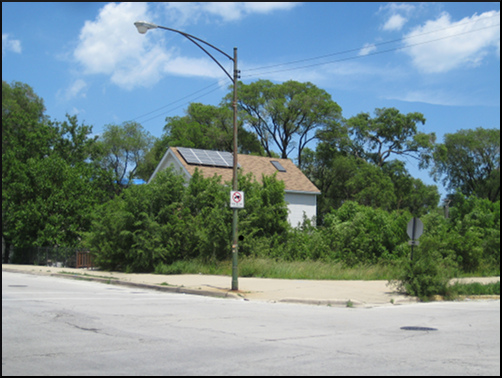- Blogs
- Posted
Off grid living, part three power
This is the third in a series of blog posts by the architect Mark Stephens on going off grid. The first post was a general introduction to the series, while the second focused on the building envelope.

Photovoltaic (PV) panels can convert sunlight directly into electricity and are a well established way of generating off-grid power. Photo by Charlie Vinz.
The next requirement after we’ve found a suitable place to live off-grid is to provide power; we’ve already introduced the concept of going passive as a way forward in order to have minimal heat demand, but we will still need to provide power to lighting and other electrical appliances.
We can divide our power demand into two areas: 1) power for lighting/electrical items and 2) power for hot water and heating
Power for lighting/electrical items
We therefore need to generate our electricity through a self-contained, renewable method — this leaves us with three options:
Wind
The concept of micro-wind generators is well established to generate electricity; the problem is that to power a serious amount of power requires a pretty big wind turbine. But the thrust of this blog post is being more aware of our electricity consumption — we will be relying less on electrical/electronic gadgets and getting back to a more simpler life where when it gets cold we add another sweater rather than increasing the heating an extra degree. Another problem is that wind turbines are notoriously temperamental over where they are located — they won’t work as effectively in built-up urban areas and even in rural locations they require minimal obstructions that cause fluctuations and disturbances in wind speed.
Water
Again the concept of a water or hydro turbine is well established; obviously they key thing here is that you need to be next to either a fast flowing stream/river or have access to a large drop on a large body of water (head) in order to turn the hydro turbine. You will obviously need to ensure that you have a legal right to use the water.
Solar
Photovoltaic (PV) panels can convert sunlight directly into electricity and are again a well established (if costly) way of generating off-grid power. Continuing the theme of reducing our electricity consumption you can obtain a small solar panel kit that provides 150 Watts of power; the key then is to run low voltage LED lights to provide your lighting. In order to power larger items such as a standard TV that work off 240V you will need an inverter.
With all of these technologies you will come unstuck if a. there’s no wind b. the water runs dry in summer and c. there’s no sun! To get round this problem you will need a bank of batteries to store the electricity you’ve generated. The batteries will need to be quite large and ‘off-gridders’ recommend the use of submarine batteries that can store and release enough electricity for a small home. Some ‘off-gridders’ use the PV panels to charge the standard AA rechargeable batteries that are then used in LED head lamps so that you can move around after sunset without bumping into things.
Power for hot water and heating
The next form of power we will require is to provide heat for cooking, heating and hot water. As discussed, by following passive house principles we will drastically reduce our space heating requirement — a certified passive house will require less than 15 kWh/m2/yr — but we will still require hot water for showers, washing etc. A solar collector (evacuated tube or flat plate collectors for example) can provide a large percentage of your hot water requirements (60-75%), the problem occurs obviously when there is less sun during the winter months and hot water is still required. The unfortunate reality is that something will still have to be burnt in order to fulfil this shortfall. A well installed and efficient wood pellet burning stove can provide hot water and heating but the more obvious example would be a simple wood burning stove with a back boiler that can provide heating to radiators, hot water and a method of cooking food. The only draw-back is that the fire needs to be lit whenever hot water is required. Again, we need a drastic rethinking over how we live our lives and to readjust to not having a source of constant hot water. It is important to note that although wood doesn’t provide as much energy as oil or gas for example when burned (therefore you will need more of it), the CO2 emissions are over 10 x better (0.025Kg CO2 per kWh for wood compared to 0.272 CO2 per kWh for oil). The obvious place therefore to be placed to be self sufficient in wood is next to a sustainable, managed forest as Ben Law did in the Woodsman’s Cottage episode of Grand Designs.
The next guest blog post takes us onto how we become more self sufficient in terms of water and food.
As always, comments welcome.
Mark Stephens RIBA MRIAI is a UK and Ireland trained chartered architect, based in Foxford, County Mayo, Ireland. He specialises in one-off, residential houses, extensions, restorations and refurbishments. His slant is a modernist approach using traditional forms and materials; his work also combines a contemporary architecture with an ecological and sustainable soundness.

